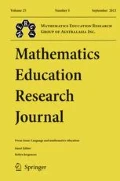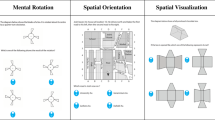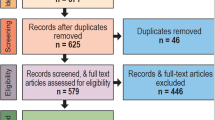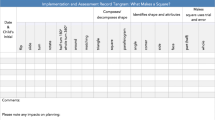Abstract
A major challenge in the field of spatial reasoning is the translation of decades of accumulated research findings from the domain of psychology and mathematics education into the school mathematics curriculum. This study aimed to operationalise a heuristic termed visualise-predict-check (VPC) for the teaching of spatial visualisation and explore the affordances for enabling teachers to foster spatial reasoning. We conducted moment-by-moment and fine-grained analysis of teaching-learning transactions of two teachers who implemented a lesson devised on the basis of the VPC heuristic. The data sources included video-taped recordings and classroom observations. The VPC heuristic provided teaching trajectories to explicitly prompt students to engage in spatial visualisation while learning mathematics and in so doing the class routine was remarkably spatially elevated. However, subtle disparities in the implementation of the lesson lead to differences in students’ engagement. The more deliberate VPC fostered students’ spatial thinking whereas the limited application of VPC tended to inhibit opportunities for reasoning spatially. VPC offers much potential to enhance spatial skills both in classroom routine teaching and in specialised interventions.

















Similar content being viewed by others
Notes
GPFD (Government Partnership for Development) project titled ‘Promoting Mathematics Engagement and Learning Opportunities for disadvantaged communities in West Nusa Tenggara, Indonesia’ was conducted in 2014–2018 in West Nusa Tenggara, funded by DFAT.
References
Arcavi, A. (2003). The role of visual representations in the learning of mathematics. Educational Studies in Mathematics, 52(3), 215–241.
Arici, S., & Aslan-Tutak, F. (2015). The effect of origami-based instruction on spatial visualization, geometry achievement, and geometric reasoning. International Journal of Science and Mathematics Education, 13(1), 179–200. https://doi.org/10.1007/s10763-013-9487-8.
Battista, M. T. (1999). Fifth graders’ enumeration of cubes in 3D arrays: Conceptual progress in an inquiry-based classroom. Journal for Research in Mathematics Education, 417–448.
Boakes, N. J. (2009). Origami instruction in the middle school mathematics classroom: Its impact on spatial visualization and geometry knowledge of students. RMLE Online, 32(7), 1–12. https://doi.org/10.1080/19404476.2009.11462060.
Bruce, C. D., & Hawes, Z. (2015). The role of 2D and 3D mental rotation in mathematics for young children: What is it? Why does it matter? And what can we do about it? ZDM, 47(3), 331–343.
Cheng, Y.-L., & Mix, K. S. (2014). Spatial training improves children’s mathematics ability. Journal of Cognition and Development, 15(1), 2.
Diezmann, C., & Lowrie, T. (2012). Learning to think spatially: What do students ‘see’ in numeracy test items? International Journal of Science and Mathematics Education, 10(6), 1469–1490. https://doi.org/10.1007/s10763-012-9350-3.
Freina, L., Bottino, R., & Ferlino, L. (2018). Visuospatial abilities training with digital games in a primary school. International Journal of Serious Games, 5(3). https://doi.org/10.17083/ijsg.v5i3.240.
Greeno, J. G. (1998). The situativity of knowing, learning, and research. American Psychologist, 53(1), 5.
Güven, B., & Kosa, T. (2008). The effect of dynamic geometry software on student mathematics teachers' spatial visualization skills. Turkish Online Journal of Educational Technology-TOJET, 7(4), 100–107.
Hawes, Z., Moss, J., Caswell, B., & Poliszczuk, D. (2015). Effects of mental rotation training on children’s spatial and mathematics performance: A randomized controlled study. Trends in Neuroscience and Education, 4(3), 60–68. https://doi.org/10.1016/j.tine.2015.05.001.
Hawes, Z., Moss, J., Caswell, B., Naqvi, S., & MacKinnon, S. (2017). Enhancing children's spatial and numerical skills through a dynamic spatial approach to early geometry instruction: Effects of a 32-week intervention. Cognition and Instruction, 35(3), 236–264. https://doi.org/10.1080/07370008.2017.1323902.
Hegarty, M., Kriz, S., & Cate, C. (2003). The roles of mental animations and external animations in understanding mechanical systems. Cognition and Instruction, 21(4), 209–249.
Hershkowitz, R. (1989). Visualisation in geometry-two sides of the coin. Focus on Learning Problems in Mathematics, 11(1), 61–75.
Johanning, D. I. (2007). Is there something to be gained from guessing? Middle school students' use of systematic guess and check. School Science and Mathematics, 107(4), 123. https://doi.org/10.1111/j.1949-8594.2007.tb17927.x.
Kim, O.-K., & Kasmer, L. (2007). Using “prediction” to promote mathematical reasoning. Mathematics Teaching in the Middle School, 12(6), 294–299.
Lim, K., Kim, O., Cordero, F., Buendía, G., & Kasmer, L. (2007). Use of prediction in mathematics classroom. Paper presented at the Proceedings of the Twenty-nineth Annual Meeting of the North American Chapter of the International Group for Psychology of Mathematics Education.
Lim, K., Buendía, G., Kim, O.-K., Cordero, F., & Kasmer, L. (2010). The role of prediction in the teaching and learning of mathematics. International Journal of Mathematical Education in Science and Technology, 41(5), 595–608.
Linn, M. C., & Petersen, A. C. (1985). Emergence and characterization of sex differences in spatial ability: A meta-analysis. Child Development, 56(6), 1479–1498. https://doi.org/10.2307/1130467.
Lowrie, T., Logan, T., & Ramful, A. (2017). Visuospatial training improves elementary students' mathematics performance. British Journal of Educational Psychology, 87(2), 170–186. https://doi.org/10.1111/bjep.12142.
Lowrie, T., Logan, T., & Hegarty, M. (2019). The influence of spatial visualization training on students' spatial reasoning and mathematics performance. Journal of Cognition and Development. https://doi.org/10.1080/15248372.2019.1653298.
Moss, J., Hawes, Z., Naqvi, S., & Caswell, B. (2015). Adapting Japanese lesson study to enhance the teaching and learning of geometry and spatial reasoning in early years classrooms: A case study. ZDM, 47(3), 377–390.
Moss, J., Bruce, C. D., Caswell, B., Flynn, T., & Hawes, Z. (2016). Taking shape: Activities to develop geometric and spatial thinking. Grades K-2: Pearson Canada Incorporated.
Newcombe, N. (2017). Harnessing spatial thinking to support stem learning. OECD Education Working Papers, 161. https://doi.org/10.1787/7d5dcae6-en.
Patahuddin, S. M., Lowrie, R., & Lowrie, T. (2018a). ELPSA learning design to develop conceptual understandings of algebraic equivalence: The use of ribbons. Australian Mathematics Teacher, 74(4), 32–40.
Patahuddin, S., Usman, H., & Ramful, A. (2018b). Affordances from number lines in fractions instruction: Students’ interpretation of teacher’s intentions. International Journal of Science and Mathematics Education, 16(5), 909–928. https://doi.org/10.1007/s10763-017-9800-z.
Patahuddin, S., Ramful, A., & Rokhmah, S. (2019). A large-scale PD intervention for improvement of teachers’ mathematical knowledge in disadvantaged communities. Paper presented at the Mathematics Education Research: Impacting Practice: Proceedings of the 42nd Annual Conference of the Mathematics Education Research Group of Australasia, Perth, Australia.
Presmeg, N. C. (1986). Visualisation in high school mathematics. For the Learning of Mathematics, 6(3), 42–46.
Ramful, A., Lowrie, T., & Logan, T. (2017). Measurement of spatial ability: Construction and validation of the spatial reasoning instrument for middle school students. Journal of Psychoeducational Assessment, 35(7), 709–727.
Sorby, S. A., & Veurink, N. (2019). Preparing for STEM: Impact of spatial visualization training on middle school math performance. Journal of Women and Minorities in Science and Engineering, 25(1), 1–23.
Uttal, D. H., Meadow, N. G., Tipton, E., Hand, L. L., Alden, A. R., Warren, C., & Newcombe, N. S. (2013). The malleability of spatial skills: A meta-analysis of training studies. Psychological Bulletin, 139(2), 352–402.
White, R., & Gunstone, R. (1992). Prediction-observation-explanation. In R. White & R. Gunstone (Eds.), Probing understanding (Vol. 4, pp. 44–64). London: The Falmer Press.
Zimmermann, W., & Cunningham, S. (1991). Editor’s introduction: What is mathematical visualization. In Visualization in teaching and learning mathematics (pp. 1–8). Washington, DC: Mathematical Association of America.
Acknowledgments
The authors would like to thank all participants involved in this research and Nur Fikriyah Ihsan for proofreading this article. This paper makes use of data from the project ‘Promoting mathematics engagement and learning opportunities for disadvantaged communities in West Nusa Tenggara, Indonesia’, supported by the Australian Government Department of Foreign Affairs and Trade under grant number 70861. Any opinion, findings, conclusions and recommendations are those of the authors.
Author information
Authors and Affiliations
Corresponding author
Additional information
Publisher’s note
Springer Nature remains neutral with regard to jurisdictional claims in published maps and institutional affiliations.
Rights and permissions
About this article
Cite this article
Patahuddin, S.M., Rokhmah, S. & Ramful, A. What does teaching of spatial visualisation skills incur: an exploration through the visualise-predict-check heuristic. Math Ed Res J 32, 307–329 (2020). https://doi.org/10.1007/s13394-020-00321-2
Received:
Revised:
Accepted:
Published:
Issue Date:
DOI: https://doi.org/10.1007/s13394-020-00321-2




